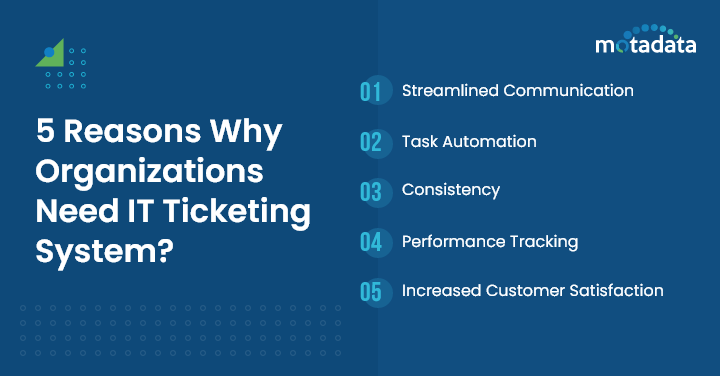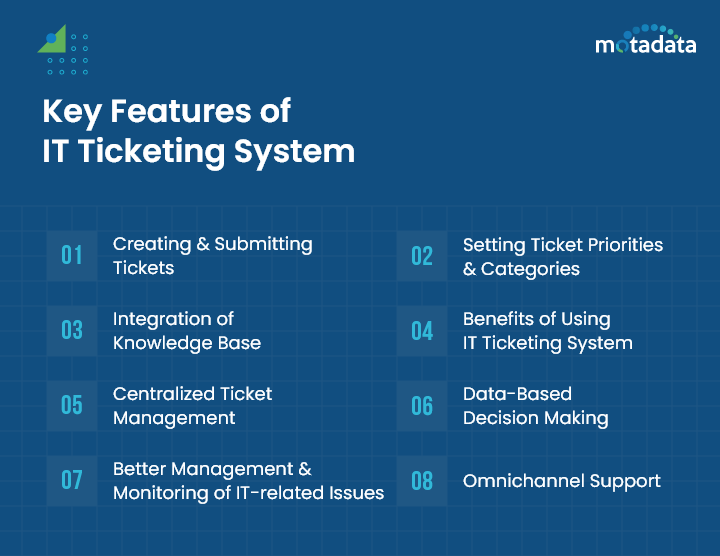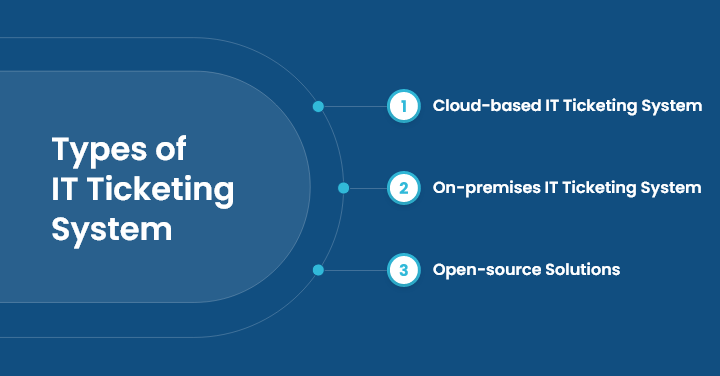Over the years, the global pandemic has brought about significant shifts in our lives and business, especially in the IT sector. Since the pandemic, many organizations have moved to working remotely and leveraging technology for most operations.
In places where it has been a great benefit, remote operations have also been challenging for organizations as managing and tracking IT-related issues from different locations was never simple.
In fact, there were communication gaps that resulted in delays in addressing user issues and more.
Hence, to make the best out of remote working, IT ticketing systems came into practice.
With the help of the IT ticketing system, customers were able to reach out to the IT service desk team and raise a ticket in real time.
IT teams later categorized these tickets and assigned priorities.
The concept not only ensured that we identified the problems as soon as possible but also addressed them as efficiently as possible, leading to the best possible outcome.
Let us dig deeper into the IT ticketing system, its working process, features, benefits, types, and challenges.
Further, we will highlight a few best practices for using an IT Ticketing System that will help your business in the long run.
What is an IT Ticketing System?
An IT ticketing system is software used by most IT companies for keeping track of their customer queries and issues.
It is a centralized tool that allows customers to submit their IT-related issues and businesses to track and manage the service request tickets efficiently.
The main purpose of initiating this IT Ticketing Software was to help streamline the whole process of issue resolution and manage IT support requests in real time.
How Does the IT Ticketing System Work?
The foundation of an IT ticketing system, also known as an IT helpdesk or service desk software, is an organized workflow.
As and when a user encounters an IT issue, he connects with the IT help desk team via communication channels like email, web portal, or chat system.
The user submits the issue and creates a new ticket listing all the details related to the issues, such as error messages, descriptions, and contact information of the user.
After submission, the enterprise ticketing system categorizes the issues based on their type and assigns priority based on the urgency and impact.
Depending on the type and priority level, the ticketing system directs the ticket to the right team or individual within IT support.
Even a notification is sent to the IT administrators updating them about the details of the issue and new task.
The customer service team then proceeds with investigation, troubleshooting, and issue resolution.
If the IT professionals fail to resolve the issue within the set timeframe, the request is forwarded to the higher-level support group.
When the problem is fixed, the support team updates the ticket to reflect the resolution.
The right IT ticketing system also helps create an extensive knowledge base for problem-solving.
5 Reasons Why Organizations Need IT Ticketing System?
Here are some of the major reasons why organizations must invest in IT Ticketing Systems:
1. Streamlined Communication
With the help of this ticket system, communication between team members and management and handling of client inquiries becomes much easier regardless of their locations, thanks to the centralized platform.
Further, it stores all the information about the issue in a centralized repository that makes it easier for support teams to track reoccurring issues and retrieve historical data.
2. Task Automation
The automation capabilities help cut down on manual labor, speed up the response time, and free up the support team to take on more difficult assignments, resulting in improved customer satisfaction and quick issue resolution.
3. Consistency
In order to guarantee that every customer receives the same quality of service, ticketing systems have the ability to impose standardized procedures and responses.
They have an IT service management team that looks after the service quality, performance metrics, custom fields, change management, project management, and IT asset management.
4. Performance Tracking
By using the statistics that the ticketing system provides, the IT department may track the effectiveness of their IT support teams, allowing for ongoing optimization and improvement
5. Increased Customer Satisfaction
With quick response time and efficient problem-solving strategies, organizations can deliver a higher level of customer satisfaction.
Also, satisfied customers are more inclined to stick with the company and refer others to it.
Key Features of IT Ticketing System
It’s crucial to take into account a number of factors in mind when selecting the right IT ticketing system for your company since these will determine how effective it is and how well it fits your unique requirements.
Here are a few essentials you must keep note of, including:
1. Creating and Submitting Tickets
Email, mobile apps, live chat, social media and web portals are a few channels that users can use to create and submit tickets.
This feature guarantees that customers can report problems in the way that suits them best.
The customer support requests are instantly tracked by the help center and prioritized, resulting in quick resolution.
2. Setting Ticket Priorities and Categories
The type of issue determines how tickets are sorted, and their influence on business operations determines their priority.
Tickets ranked as high priorities are handled right away.
3. Integration of Knowledge Base
The support team may quickly resolve issues by gaining access to pertinent data, best practices, and solutions through integration with knowledge bases.
4. Benefits of Using IT Ticketing System
Today, many businesses depend on effective IT support to guarantee seamless operations and top-notch client experiences. Here are a few other benefits of the IT Ticketing System, including:
5. Centralized Ticket Management
A ticketing system facilitates the collection, tracking, and management of support tickets through a centralized platform, leading to a more streamlined and effective support process.
Customers no longer need to communicate through several channels.
Also, this help desk software minimizes the chances of missing or leaving tickets unresolved by keeping all issues and customer requests in one location.
6. Data-Based Decision Making
IT teams can make wise decisions with the use of the insightful data received by ticketing systems.
A foundation for ongoing improvement is provided by metrics like customer feedback, ticket response times, and resolution timeframes.
7. Better Management and Monitoring of IT-related Issues
Since each ticket is given a unique ID, we can manage and track them easily.
IT teams are able to prioritize issues according to their impact and severity, guaranteeing that they handle urgent issues quickly while upholding an equitable and uniform methodology.
8. Omnichannel Support
Some solutions fully integrate an omnichannel solution, saving employees from the need to use a limited number of channels or being forced to use one or two designated channels.
Types of IT Ticketing System
There are different types of ticketing systems in the market that help businesses better track, report, and resolve service requests.
Let’s have a look at different types of IT ticketing systems along with real-world examples and case studies.
1. Cloud-based IT Ticketing System
One of the efficient software solutions for managing and resolving IT support issues is hosted on the vendor’s servers and accessed via the Internet.
You do not require any expertise to set up the cloud-based system. Further, it is cost-effective and integrates well with other ITOM tools.
For example, Zendesk – a customer service software. Let’s assume a company opted for Zendesk’s cloud-based solution, or one of the Zendesk alternatives, to improve its overall efficiency and reduce costs.
The organization was able to quickly deploy the system without having to make a substantial investment in infrastructure because it was hosted on Zendesk’s servers.
Further, the Cloud-based IT Ticketing System offers more flexibility, which enables the support agents to view and handle tickets from any location.
2. On-premises IT Ticketing System
The On-premises ticketing solution offers more control over data and guarantees privacy protection.
Unlike the cloud-based solution, it is set up and maintained by the in-house organizational servers.
These systems contain performance measurements and service level agreement monitoring, and they offer complete offline access to assist operations.
For example, Jira Service Desk – one of the popular help desk software in the market used by most companies to improve control over sensitive data.
For monitoring the success of the service team in providing the best possible customer experience, Jira Service Desk software provides additional comprehensive data.
Incident reports, SLA goals and their status, and overall workloads are a few of the metrics. Supporting agents that are handling different types of customer support and many projects can also benefit from this capability.
3. Open-source Solutions
The solution gives companies access to the system’s core source code, enabling them to improve, alter, and adapt it to meet their unique needs.
Employees and users have full access to tailor the system as per their requirements and make the best out of it.
If you are looking for a cost-effective solution that is also highly customizable, it is the best option for your business.
OTRS (Open-source Ticket Request System) is the best example for this type of IT Ticketing System.
With this solution, companies can utilize the system’s fundamental source code’s flexibility, modify and adjust it to meet their own needs.
Further, the solution enables companies to allocate resources to other important areas of their IT infrastructure at a lower cost.
How to Implement IT Ticketing System?
The adoption of an IT ticketing system streamlines support requests, guarantees prompt customer assistance, and boosts team output.
It enables effective customer issue tracking, routing, prioritization, organizing, and resolution.
Hence, firstly, determine the organization’s objectives and unique requirements before selecting a ticketing system.
Look for scalability, flexibility, and integration capabilities, and based on your assessment select the right tool for your organization.
Make sure the support team gets comprehensive training for a smooth onboarding process.
With the help of this tool, you can improve customer satisfaction and constantly monitor system performance.
Common Challenges with IT Ticketing Software
Implementing an IT ticketing software offers several benefits, but at the same time, it comes with various challenges, such as:
1. Resistance to Change
Employees who are more satisfied with the older techniques and email-based communications might resist moving to the new practice.
Additionally, organizations will have to run training sessions for employees and users to overcome this resistance.
2. Selecting the Right Help Desk Ticketing System
It can be difficult to select the IT help desk system that best fits the demands of your company.
There are many options, but it is vital to choose the one that fits your unique requirements and workflows.
3. Data Migration
Another challenge that an organization might face is data migration.
It can be difficult to transfer current ticket data and information from spreadsheets or outdated systems to the new ticketing system.
Accuracy and data integrity must be upheld throughout this procedure.
Best Practices of Using IT Ticketing System
Using best practices can help your organization get the most out of its ticketing software and increase its efficacy and efficiency.
The following are some essential ticketing software best practices:
1. Standardize Ticketing Procedure
Create uniform procedures and workflows for the ticket creation and resolution.
To guarantee that tickets are handled consistently and effectively, roles and responsibilities must be clearly defined.
Also, it takes time and effort to become accustomed to new software and ticketing operations, even with a mild learning curve, so define the roles and responsibilities for better understanding.
2. Provide Ticketing Details
Make sure that the users fill up their tickets with precise and thorough information.
Give support agents as much information as possible to help them understand and resolve the issue quickly, such as the ticket type, issue description, screenshots, error messages, and any other relevant details.
3. Update Ticket Status and Progress Frequently
Update ticket status and progress frequently to help you keep a proactive attitude to ticket management.
Because of this, consumers can monitor the progress of their tickets, and less needless follow-ups are required.
A regular update schedule also informs stakeholders about the status of ongoing challenges.
Emerging Trends in IT Ticketing Systems
Several trends and projections for the future are influencing the growth and use of IT ticketing systems, which are now an essential part of the IT infrastructure of modern businesses.
Here are some significant developments and forecasts for IT ticketing systems in the future:
1. Artificial Intelligence (AI) Integration
Chatbots and virtual assistants with AI capabilities can handle common questions, automate the production and routing of tickets, and offer prompt replies, all of which increase productivity and client satisfaction. Vertical AI agents take this further by handling more complex tasks like tracking orders and providing personalized responses.
2. Self-Service
In order to enable users to find solutions on their own, reduce ticket volumes, and improve customer experiences, organizations are investing in powerful knowledge management systems, user-friendly self-help websites, and community forums.
3. Ticket Categorization with Machine Learning
Automating ticket routing and classification is achieved through the use of machine learning techniques.
Through the examination of ticket content, machine learning models can precisely classify and allocate tickets to the relevant teams or departments, thereby decreasing manual labor and enhancing the efficiency of ticket handling.
How to Select the Right IT Ticketing System for Your Customer Support?
Here are a few features and functionalities that one must keep in mind when selecting the right IT Ticketing System for your customer support:
User-Friendly Interface – Make sure the tool you select comes with an intuitive and user-friendly interface as it results in the effective handling of tickets.
Further, a smooth user experience is guaranteed by the system’s well-organized design.
Customizable – Another feature one must look for is the supported customization options.
These settings will help adjust the ticketing system to meet the unique needs of your company.
You can set up ticket categories, priority, and workflows to correspond with your particular support procedures.
Automation and AI Capabilities: A system utilizing AI and automation technologies for ticket classification, routing, and response helps increase overall operating efficiency by lowering manual labor and expediting ticket resolution.
How Motadata.com Can Improve Your IT Support System with its IT Ticketing Feature?
With its robust IT Ticketing feature, Motadata.com distinguishes itself as a top choice for IT support and has the potential to greatly improve your system.
It comes with a wide range of comprehensive features that help employees effectively handle client issues and support requests.
IT assistance, client inquiries, and satisfaction are all streamlined by Motadata’s services, which include measuring performance indicators and managing service level agreements.
Repetitive question answering might take a lot of time. To lessen the workload for IT support personnel, end users can access the self-service and knowledge management features, motivating them to resolve problems on their own before submitting a ticket.
Additionally, you can utilize REST API to integrate Motadata ServiceOps with any other third-party technologies.
In summary, through the use of Motadata, businesses may improve the efficiency and effectiveness of their IT support procedures, leading to increased customer satisfaction and company success.
You can even go for the free trial and track the customer data or check its exclusive features.
FAQs
Organizations of all sizes and industries can invest in IT ticket systems and ensure efficient problem management and resolution.
Be it government agencies, educational institutions, small businesses, or large corporations, all can leverage the IT ticketing system
IT ticket systems offer a centralized platform for reporting, classifying, and resolving issues, which makes them essential to incident management.
They aid in prioritizing incidents according to their impact and severity, guaranteeing that urgent issues are dealt with right away.
Employing encryption and access controls, monitoring security breaches frequently, selecting a solution compliant with applicable regulations (e.g., GDPR or HIPAA), and training staff on appropriate data handling protocols are all important steps in ensuring data security and compliance when utilizing an IT ticketing system.
An IT ticket system offers valuable insights for business improvement using analytics and reporting tools.
Businesses may find areas for improvement and reoccurring difficulties by evaluating data on IT issues.
By tracking customer satisfaction scores, resolution rates, and response times, companies may enhance their procedures and aid in well-informed decision-making.
An IT ticketing system’s security is contingent upon the solution selected and the vendor’s deployed security measures.
For example, some IT ticketing systems protect user privacy by implementing security features like encryption and restricted access.
Well-defined policies and processes must exist for data privacy. Regular security assessments and updates contribute to the system’s continued security.








